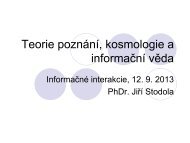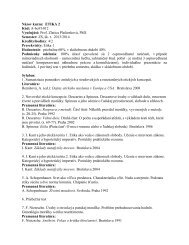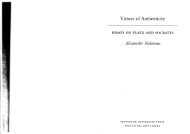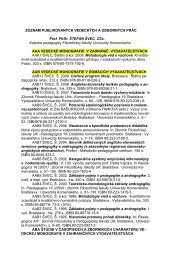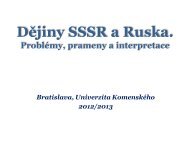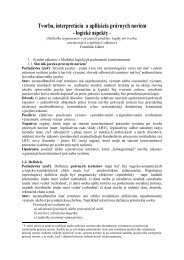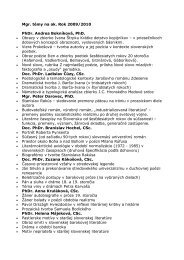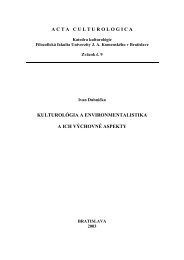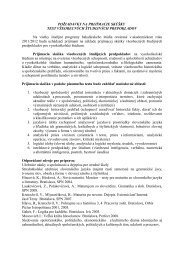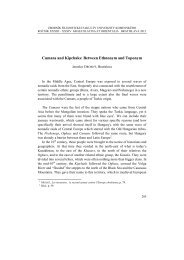Department of British and American Studies at the - Univerzita ...
Department of British and American Studies at the - Univerzita ...
Department of British and American Studies at the - Univerzita ...
Create successful ePaper yourself
Turn your PDF publications into a flip-book with our unique Google optimized e-Paper software.
To illustr<strong>at</strong>e <strong>the</strong> problem <strong>of</strong> rel<strong>at</strong>ive intentionality, let us pose a few questions rel<strong>at</strong>ed<br />
to Tiresias, <strong>the</strong> only possible central persona <strong>of</strong> <strong>the</strong> poem.<br />
How do we imagine Tiresias? Wh<strong>at</strong> voice does he or it speak or use? Old or young?<br />
More similar to <strong>the</strong> music <strong>of</strong> Babylonia or Ragtime (or this metaphysical ―oooo<br />
Shakespearean rag‖ – verse 128)? Is his voice a high pitch or a bass, more masculine or<br />
feminine, or ―<strong>and</strong>rogynous‖? Is it engaged, enflamed, or r<strong>at</strong>her withdrawn or even robotic-<br />
autom<strong>at</strong>ic? Melodram<strong>at</strong>ic or reconciled? Is his mind still in <strong>the</strong> time immemorial, in <strong>the</strong><br />
mythic time as he peers <strong>at</strong> <strong>the</strong> banality <strong>of</strong> <strong>the</strong> mundane unreal city life? How does his<br />
<strong>at</strong>emporal experience <strong>and</strong> its tension with <strong>the</strong> experience <strong>of</strong> <strong>the</strong> present inform his voice, tone,<br />
<strong>and</strong> supposed intentionality?<br />
A single-minded answer to any <strong>and</strong> all <strong>of</strong> <strong>the</strong>se questions would dem<strong>and</strong> reducing our<br />
overall interpret<strong>at</strong>ion <strong>of</strong> <strong>the</strong> poem‘s meaning to one level, to one line. But th<strong>at</strong> would not be<br />
productive or appropri<strong>at</strong>e <strong>at</strong> all because <strong>the</strong> poem‘s identity, its distinct quality, also lies in <strong>the</strong><br />
fact it is designed as a meaningful field <strong>of</strong> multiple identities, voices <strong>and</strong> even rel<strong>at</strong>ive pitches<br />
or intentionalities working in a mode <strong>of</strong> both affirm<strong>at</strong>ive <strong>and</strong> subversive appropri<strong>at</strong>ion <strong>of</strong> <strong>the</strong><br />
original genre <strong>and</strong> cultural <strong>and</strong> historic identity <strong>and</strong> canonised or established version <strong>of</strong> <strong>the</strong><br />
―message‖.<br />
Tiresias‘ mind is not only present in all points in time in a linear line, but his<br />
perspective is also as if on a plane above <strong>the</strong> causality <strong>and</strong> temporary or limited identity <strong>of</strong><br />
those immersed in ―local‖ time <strong>and</strong> sense <strong>of</strong> space. As a result, his ―mind‖, not necessarily<br />
just as a biological identity but also as an identity <strong>of</strong> tradition, transcends conventional<br />
concepts <strong>of</strong> identity <strong>of</strong> a ―human‖ lyrical subject.<br />
Given this quality <strong>of</strong> ―experience‖ <strong>of</strong> <strong>the</strong> totality <strong>of</strong> experience, Tiresias does not fall<br />
victim to emotions, but is r<strong>at</strong>her a dry, desol<strong>at</strong>e, even more strongly a depersonalized<br />
observer. As his is primarily <strong>the</strong> consciousness <strong>of</strong> wh<strong>at</strong> is ―bound to come‖, it is a<br />
consciousness <strong>of</strong> evidence r<strong>at</strong>her than experience, even though from his perspective <strong>the</strong><br />
unfolding history is still his ―mental event‖ – while outside his will, still not outside his<br />
sensory <strong>and</strong> cognitive experience.<br />
So, in a sense, <strong>the</strong> figure <strong>of</strong> Tiresias, with its weight <strong>of</strong> universal evidence made<br />
personally relevant, st<strong>and</strong>s for Eliot‘s own controlling self in <strong>the</strong> text. All <strong>of</strong> <strong>the</strong> allusions,<br />
literary references, <strong>the</strong>mes, <strong>and</strong> images made <strong>the</strong>ir way into <strong>the</strong> poem only because <strong>the</strong>re was<br />
Eliot‘s control combining conscious <strong>and</strong> intuitive (i.e. anthropologically <strong>at</strong>emporal <strong>and</strong><br />
archetypal) approaches <strong>and</strong> procedures <strong>of</strong> inclusion.<br />
Slovak <strong>Studies</strong> in English, Vol. 3, 2011 – Identity in Intercultural Communic<strong>at</strong>ion<br />
199



